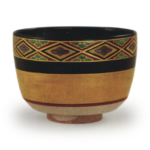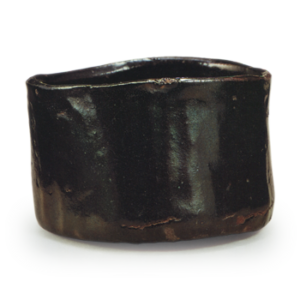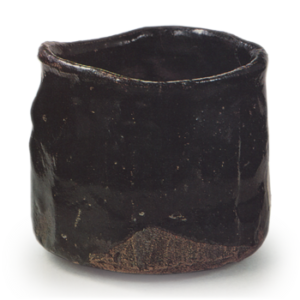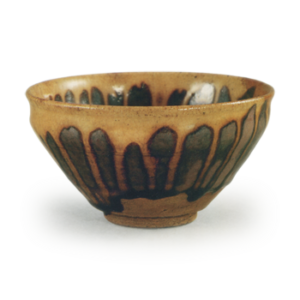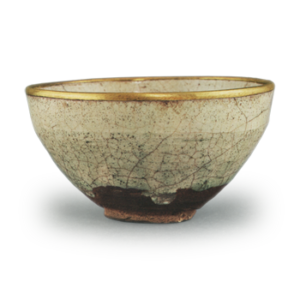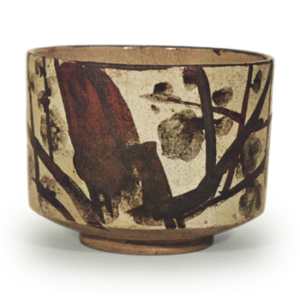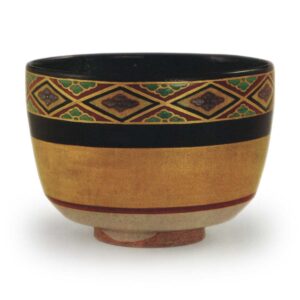

Height: 8.4cm
Diameter: 11.4cm
Outer diameter of foot: 5.2-5.3cm
Height of foot: 0.8cm
The design is relatively simple for a NINSEI overglaze-decorated tea bowl, with a half-cylindrical shape and a checkered pattern of diamond shapes and horizontal stripes, but the good proportions, clever color scheme and especially the bold use of gold make it a very attractive and luxurious piece. This is another unusual tea bowl by NINSEI, and is a rare piece that has hardly been shown to the public before. A similar example is the gold and silver diamond-patterned tea bowl in the collection of the Atami Museum of Art, and this is one of the few examples of its kind.
The clay is probably Shigaraki clay, and it is well refined, pure, and finely fired, with a pale yellowish-white color on the foot ring, and a little red burn on the rim. The overall shape is thinly made and light to the touch, and it has been pulled up into a refined half-cylindrical shape using the same skillful potter’s wheel. It has a beautiful shape that shows a slight bulge in the body and widens slightly at the rim. The foot ring is slightly thinner than usual, but it is thicker than usual, and it has been firmly and powerfully carved out, with a wide chamfer at the waist. This is a shape that has been carefully considered, and it is calculated based on the dimensions of the horizontal striped pattern on the body.
The glaze is first applied to the entire inside surface of the rim, and is called Nisei black. It is a beautiful black glaze unique to Nisei, which melts at a lower temperature than normal glazes and has a soft luster. The inside surface shows the marks of the potter’s wheel through this black glaze, and a round tea pool is formed on the deep bottom surface.
Now, on the outside, several bands are neatly layered. The uppermost layer near the rim is a band pattern with a floral diamond design in a diagonal lattice, painted in colors. The silver floral pattern on a yellow background and the green floral pattern on a red background are repeated, one within a diamond-shaped black frame and the other within a split diamond-shaped gold frame, forming a rich and gorgeous band pattern that circles around the entire piece.
The next layer is a slightly wider plain black obi pattern, followed by a wide, luxurious gold obi. In other words, the upper half of the side is black, and the lower half is gold, with a floral diamond obi pattern added to the black upper half. The shape is made up of a black background with a gorgeous colored obi pattern, and the gold background is left plain and wide. The proportion of the combination is truly superb.
The gold ground just below the waist line is covered with a milky, translucent, elegant white glaze that extends to the foot of the vase. A thin red line is drawn at the boundary between the gold ground and the white glaze, and the waist is firmly wrapped up, but the glaze on the side of the foot of the vase is uneven, and the clay surface appears in its natural form. While the overall piece is precisely handled with vivid colors and well-defined lines, the foot ring area is a scene of disorder. This is an effective technique that Nisei is good at, and it is an attempt to save the weak point of this kind of design, which tends to be stiff.
The flower-shaped diamond pattern on the right and the gold-colored areas are not painted on top of the glaze, but rather appear to have been painted directly on the well-prepared surface of the clay body, and then the gold-colored designs were fired on top of the painted designs. Even in these areas, we can see the careful technique of Nisei, and we are impressed by his thorough attention to detail. As usual, the small seal of “Ninsei” is stamped on the underside of the foot ring.
There are no accessories to mention.
It was passed down in the Tamura family of Osaka, who are related to the family of Fusanosuke Kuhara. It was sold by the Tamura family in 1936, and is now in the collection of a certain person in Osaka.

